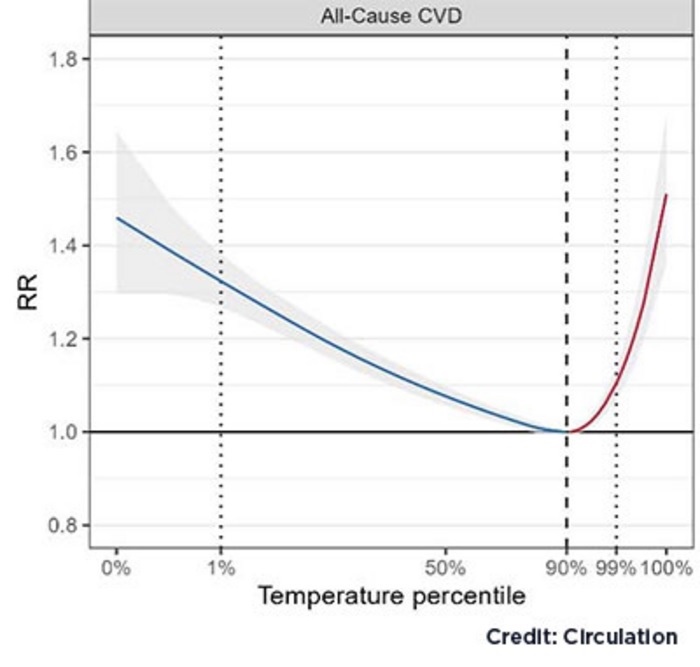International analysis suggests that extreme temperatures increase the risk of death from heart failure, pointing to the need for mitigation strategies in the era of climate change.
Summary Introduction : Cardiovascular disease is the leading cause of death in the world. Existing studies on the association between temperatures and cardiovascular deaths have been limited in geographic areas and have generally considered associations with total cardiovascular deaths rather than cardiovascular deaths from specific causes. Methods: We used unified data collection protocols within the Multi-City Collaborative Network to assemble a database of daily counts of specific cardiovascular causes of death from 567 cities in 27 countries on 5 continents in overlapping periods ranging from 1979 to 2019. Specific daily ambient temperatures were obtained from weather stations and climate reanalysis models. To investigate the associations of cardiovascular mortality with extreme hot and cold temperatures, we fitted case-crossover models in each city and then used a mixed-effects meta-analytic framework to pool estimates from individual cities. Extreme temperature percentiles were compared with the minimum mortality temperature in each location. Excess deaths were calculated for a range of days with extreme temperatures. Results: Analyzes included deaths from any cardiovascular cause (32,154,935), ischemic heart disease (11,745,880), stroke (9,351,312), heart failure (3,673,723), and arrhythmia (670,859). At extreme temperature percentiles, hot (99th percentile) and cold (1st percentile) were associated with an increased risk of dying from any cardiovascular cause, ischemic heart disease, stroke, and heart failure compared with minimum mortality temperature, which is the temperature associated with lower mortality. Across a range of temperature extremes, hot days (above the 97.5th percentile) and cold days (below the 2.5th percentile) accounted for 2.2 (empirical 95% CI [eCI], 2.1– 2.3) and 9.1 (95% CI, 8.9–9.2) excess deaths per 1000 cardiovascular deaths, respectively. Heart failure was associated with the highest proportion of excess deaths from extreme hot and cold days with 2.6 (95% CI, 2.4–2.8) and 12.8 (95% CI, 12. 2–13.1) per 1000 heart failure deaths, respectively. Conclusions: In a large, multinational sample, exposure to extremes of hot and cold temperatures was associated with increased risk of mortality from multiple common cardiovascular conditions. The intersections between extreme temperatures and cardiovascular health must be thoroughly characterized today, and especially in a changing climate. |

The graph shows temperature percentiles and the relative risk of dying from heart disease in 567 countries. The dashed line represents the temperatures associated with the lowest risk of death. The dashed lines represent the 1st percentile (extreme cold) and the 99th percentile (extreme heat).
Comments
Exposure to extremely high or low temperatures increases a heart disease patient’s risk of death, according to a new study published in the American Heart Association journal Circulation . The global analysis of more than 32 million cardiovascular deaths over 40 years measured more deaths on days when temperatures were higher or lower compared to days with more moderate weather.
"It underscores the urgent need to develop measures that help our society mitigate the impact of climate change on cardiovascular disease," said study co-author Haitham Khraishah, MD, a cardiovascular disease fellow at the University of Massachusetts Medical School. Maryland (UMSOM). and the University of Maryland Medical Center (UMMC).
Among cardiovascular disease types, people with heart failure were more likely to be negatively affected by very cold and very hot days, experiencing a 12% higher risk of dying on days of extreme heat compared to days of optimal temperature in a specific city. Extreme cold increased the risk of death from heart failure by 37 percent.
The findings were based on an analysis of health data of more than 32 million cardiovascular deaths that occurred in 567 cities in 27 countries on 5 continents between 1979 and 2019. The definition of extreme weather differed from city to city. It was defined as the top 1 percent or bottom 1 percent of the "minimum mortality temperature," which is the temperature at which the lowest mortality rate is achieved.
For every 1,000 cardiovascular deaths, researchers found that:
- Extreme heat days (above 86°F in Baltimore) accounted for 2.2 additional deaths.
- Extremely cold days (below 20°F in Baltimore) accounted for 9.1 additional deaths.
Of the types of heart disease, the highest number of additional deaths were found in people with heart failure (2.6 additional deaths on days of extreme heat and 12.8 on days of extreme cold).
"While we don’t know the reason why the effects of temperature were more pronounced in patients with heart failure, it could be due to the progressive nature of heart failure as a disease," Dr. Khraishah said. “One in four people with heart failure are readmitted to the hospital within 30 days of discharge, and only 20 percent of heart failure patients survive 10 years after diagnosis.”
Climate change has been found to cause extreme weather events at both ends of the spectrum, with warmer summers and colder winters. A 2021 study published in the journal Science found that Arctic warming caused a change of events that led to a disruption of the polar vortex that caused periods of extreme cold in the Northern Hemisphere.
Barrak Alahmad, MD, PhD, a researcher at the Harvard TH Chan School of Public Health at Harvard University in Boston and a faculty member at the School of Public Health at Kuwait University in Kuwait City, was the study’s corresponding author. . Dr. Khraishah and Dr. Alahmad led an effort over the past four years to build the heart disease mortality database for this study with their colleagues from more than 35 institutions around the world.
The team developed and expanded the heart disease mortality database as part of the Multi-Country, Multi-City (MCC) Collaborative Research Network. This is a consortium of epidemiologists, biostatisticians, and climate scientists who study the health impacts of climate and environmental stressors related to mortality rates.
"This study provides an indisputable link between extreme temperatures and heart disease mortality from one of the largest multinational data sets ever assembled," said Mark T. Gladwin, MD, Dean, UMSOM, Vice President for Medical Affairs, University of Maryland, Baltimore, and the John Z. and Akiko K. Bowers Distinguished Professor. "Data can be mined deeper to learn more about the role of health disparities and genetic predispositions that make some populations more vulnerable to climate change." Such questions will be addressed in future research, according to Dr. Khraishah.
Some limitations of the study include an underrepresentation of data from South Asia, the Middle East, and Africa. It could be that extreme heat had more impact than initially measured due to this lack of data.
The researchers took into account humidity and air pollutants, which could have explained the excess deaths in places with extreme temperatures. They also controlled for the delayed effect of temperature on human health (lag effect) and the climate zone.
"This landmark document is a call to consider climate change as a growing public health problem and highlights the need to investigate it as a possible cause of health disparities," said Stephen N. Davis, MBBS, chair of the Department of Medicine at the UMSOM and Chief Physician of the UMMC.
This analysis was funded by the Kuwait Foundation for the Advancement of Science.
















